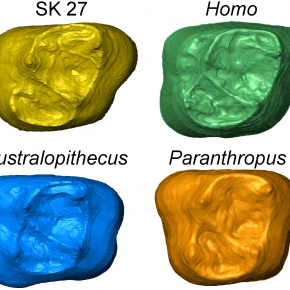Significance
Identifying the earliest members of the genus Homo is crucial for understanding when and where selective pressures resulted in its emergence from a Plio-Pleistocene hominin taxon. Our revision of a large part of the dental fossil record from southern Africa provides evidence suggesting a paucity of Homo remains and indicates increased levels of dental variation in australopith taxa. Results of the Ba/Ca, Sr/Ca, and elemental mapping of enamel and dentine also indicate that some of the purported Homo specimens show a paleoecological signal similar to that of the australopiths.
Abstract
The origins of Homo, as well as the diversity and biogeographic distribution of early Homo species, remain critical outstanding issues in paleoanthropology. Debates about the recognition of early Homo, first appearance dates, and taxonomic diversity within Homo are particularly important for determining the role that southern African taxa may have played in the origins of the genus. The correct identification of Homo remains also has implications for reconstructing phylogenetic relationships between species of Australopithecus and Paranthropus, and the links between early Homo species and Homo erectus. We use microcomputed tomography and landmark-free deformation-based three-dimensional geometric morphometrics to extract taxonomically informative data from the internal structure of postcanine teeth attributed to Early Pleistocene Homo in the southern African hominin-bearing sites of Sterkfontein, Swartkrans, Drimolen, and Kromdraai B. Our results indicate that, from our sample of 23 specimens, only 4 are unambiguously attributed to Homo, 3 of them coming from Swartkrans member 1 (SK 27, SK 847, and SKX 21204) and 1 from Sterkfontein (Sts 9). Three other specimens from Sterkfontein (StW 80 and 81, SE 1508, and StW 669) approximate the Homo condition in terms of overall enamel–dentine junction shape, but retain Australopithecus-like dental traits, and their generic status remains unclear. The other specimens, including SK 15, present a dominant australopith dental signature. In light of these results, previous dietary and ecological interpretations can be reevaluated, showing that the geochemical signal of one tooth from Kromdraai (KB 5223) and two from Swartkrans (SK 96 and SKX 268) is consistent with that of australopiths.
Read more:
https://www.pnas.org/doi/10.1073/pnas.2111212119
https://www.inee.cnrs.fr/index.php/fr/cnrsinfo/les-premiers-humains-en-afrique-australe
© C. Zanolli et Ditsong National Museum of Natural History







